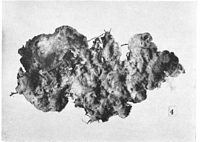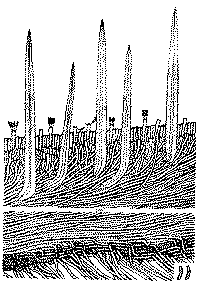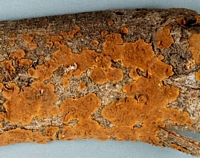|
 Hymenochaete gladiola Hymenochaete gladiola
BiostatusPresent in region - Indigenous. Endemic
Images (click to enlarge)
Caption: Pl. 1, Fig. 4. Hymenochaete gladiola G.H.Cunn. x 1. Umbonate-sessile pilei with incurved
margins. | 
Caption: Text-fig. 2. Hymenochaete gladiola G.H.Cunn. Transverse section x 500; spores x 1000. | 
Owner: Barbara Paulus |
Article: Cunningham, G.H. (1957). Thelephoraceae of New Zealand. XIV. The genus Hymenochaete. Transactions of the Royal Society of New Zealand 85(1): 1-51.
Description: Hymenophore pileate, annual, membranous-coriaceous, commonly composed of broad
resupinate areas with narrow marginal pilei, sometimes umbonate sessile and orbicular with
narrow reflexed edges, or occasionally resupinate, loosely attached, irregularly linear, 4-20 x
3-6 cm. Pileus surface chestnut-brown to umber, with lighter chestnut margin, tomentose,
sometimes radiately zonate; hymenial surface date brown with umber periphery and fulvous
margin, not creviced, even or more usually following irregularities of the pileus surface,
velutinate with the dark setae; margin acuminate, lobed, slightly incurved or erect, bright
fulvous. Context chestnut brown with darker abhymenial hairs, 0.25-0.4 mm thick, of mainly
radiately arranged hyphae parallel with the hymenium, bordered by a conspicuous intertwined
and cemented coloured cortex, and sometimes a fragmental colour zone beneath the
subhymenium; hyphal system dimitic; skeletal hyphae chestnut brown, 3-4 µ diameter, walls
0.5-1 µ thick, naked, sparsely branched, sparsely septate; generative hyphae 2-3 µ diameter,
walls 0.2 µ thick, hyaline, freely branched and septate. Setae confined to a single row, arising
from the base of the subhymenium, projecting to 150 µ, aculeate, sometimes curved at the
base, 95-200 x 10-16 µ, walls naked, reddish brown, lumina narrow. Hymenial layer to 40 µ
deep, a close hyaline palisade of basidia and paraphyses. Basidia subclavate, 22-26 x 4-5 µ, 2-4-spored;
sterigmata slender, upright, to 6 µ long. Paraphyses mostly cylindrical, the same
diameter and about two-thirds the length of the basidia. Spores allantoid, 7-9 x 2-2.5 µ, walls
smooth, hyaline, 0.1 µ thick.
Habitat: HABITAT: Effused on bark of dead branches associated with a pocket rot.
Distribution: DISTRIBUTION: New Zealand.
Notes: Readily identified among species with a cortex by the unusually long, aculeate, naked setae
which arise in a single row and project for the greater part of their length, and the narrow
allantoid spores.
Fructifications commence as numerous small orbicular colonies. These soon merge to form
(a) linear resupinate areas, (b) umbonate orbicular colonies with erect margins, or (c)
umbonate-sessile patelliform plants with free plane margins. At first the pileus surface is
bright chestnut, and darkens with age; the hymenial surface is date-brown, changing to
chestnut where rubbed, and remains even or may become tardily creviced. Margins are broad
and fulvous or chestnut. Sometimes an interrupted colour zone develops beneath the
subhymenium, but is as often absent. Other noteworthy features are the limited host range,
and pocket rot produced in the host tissues.
The species possesses setae similar to those of H. sallei Berk. & Curt., and some pilei
resemble those of H. berkeleyana (Mont.) Cke. From both it differs in possessing a
conspicuous cortex.
|